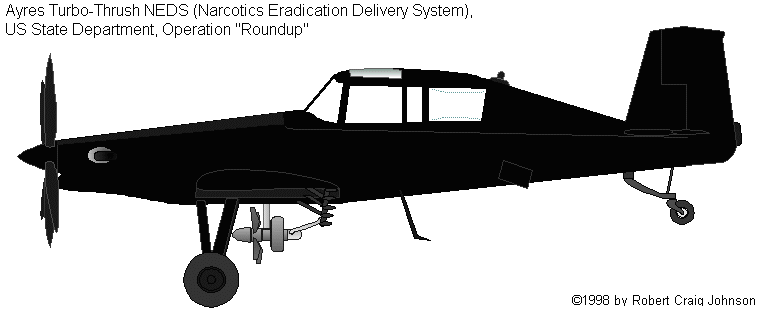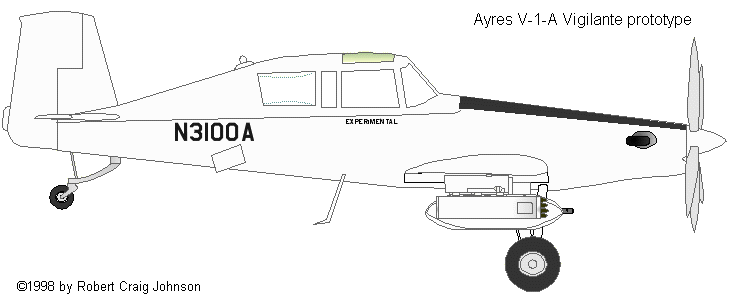
For much of the last quarter century, the United States government has been fighting a secret air war in the jungles of Southeast Asia and in the cloud forests of Central and South America. But in this case, the usual fleet of small, unmarked aircraft are not manned by USAF Special Operations crews or CIA mercenaries, and the enemy is not international communism. Instead the pilots are contractors working for the United States Department of State, and their enemies are plants—specifically, marijuana, opium, and coca. The eradication of these species by aerial application of herbicides has been an ongoing if largely unpublicized feature of American foreign policy since the 1970s. To implement this policy, the United States has deployed a number of specialized, paramilitary aircraft, drawn from military surplus stocks and modified or purpose-built by specialty manufacturers. Among the latter is this month's subject, the Ayres Turbo-Thrush NEDS (Narcotics Eradication Delivery System), a curious hybrid crop duster and counter-insurgency aircraft.
The herbicide campaign got off to a somewhat shaky start in the 1970s. Operation "Ranch Hand," the defoliation of large tracts in Vietnam, was still fresh in the public's memory, and early reports of the toxicity of the chemical used in the operation, Agent Orange, were just starting to come to light. There was thus considerable outcry when it became known that the US had started spraying Mexican and Columbian marijuana with something similar, an allegedly even less safe herbicide called Paraquat. Fears for the health of teenagers who might smoke or consume contaminated marijuana quickly forced a halt to the operation. At roughly the same time, one of the third world's periodic waves of nationalism made it harder for governments in the drug-producing regions to let Yanqui agents and airplanes range freely over their sovereign territory spraying potentially toxic substances that destroyed what were usually traditional, local cash crops. But these reverses were, as it turned out, only temporary.
By the early 1980s, America was discovering cocaine, a South-American alkaloid that had been out of fashion there since the 1920s. The Reagan-era's unbridled admiration for wealth (however obtained), its love of ostentatious luxury, its contempt for government authority, and, above all, its selfishness created an insatiable demand for this drug and for the now-fashionable aura of moneyed decadence and political extremism that had surrounded it since its last vogue. Doctors and mid wives "did" it at suburban cocktail parties. Arbitragers, bankers, and stock brokers did it in executive washrooms. Real estate tycoons did it in their Range Rovers, while their girlfriends did it inside on the dance floors of trendy night clubs. Bartenders, truck drivers, secretaries, and construction workers followed suit as means or credit would allow. The one thing that had ever had any hope of making drug prohibition work in America—the average man's and woman's respect for the law and his or her sense of civic responsibility—was thus swept away in a sort of orgiastic, national binge. Yet, paradoxically, as the will to "just say 'no'" faded and as the compactness of the highly concentrated cocaine powder (at least when compared to bulky bales of cannabis leaf) made traditional enforcement tactics, such as Customs inspections, all but ineffectual, public demands for enforcement, for "action" on the "drug problem," became ever more shrill. Americans, it seems, wanted government that governed them least, but also wanted it to govern someone else more.
It was against this background that the aerial application of herbicides enjoyed something of a renaissance. The Reagan and Bush administrations took our American national weakness—the love of easy answers to complex questions—to extremes in almost every aspect of American life, but in none more so than in drug policy. Spraying was politically attractive because it was a simple, technological fix that did not require any painful, national self-examination. Environmental concerns and the sensitivities of foreigners did not command much sympathy in the electorate at the time, and suitable equipment was available in quantity, due to the Administration's explosive, cost-is-no-object military procurement binge. All kinds of perfectly serviceable, older combat aircraft were now surplus to requirements and on offer to any public agency that would use them. There were more aircraft than takers. Among these were a number of Marine-Corps OV-10D Bronco observation/COIN aircraft. They were fitted with night-vision equipment and had been assigned to the Alcohol, Tobacco, and Firearms division of the Treasury Department. ATF does not seem to have had any clear use in mind for the aircraft, however, and they were soon transferred to the State Department for spraying duties. Possibly, the State Department assumed responsibility for the herbicide mission to lessen the profile of the operation and avoid the provocativeness of a military deployment. Be that as it may, the airplanes were painted black with subdued red trim (as shown on p. 50 of the Squadron-Signal book OV-10 Bronco in Action) and fitted with commercial crop-dusting tankage and windmill-driven sprayers. Then they went into action in South America. While use of the herbicide Spike on coca fields caused some controversy (the substance was alleged to be particularly damaging to the forests of the coca-growing region), the program generally went unnoticed in the US.
The Bronco did not go unnoticed, however, in the mountain valleys of Bolivia, Columbia, Peru, Thailand, and Burma. The growers quickly recognized the threat and threw their considerable resources against the aircraft. Machine guns, automatic antiaircraft cannon, and shoulder-launched missiles were soon being fired against the Broncos, and it quickly became clear that they were not fully up to the job. They had not been designed for a high-threat environment and were known to be vulnerable to IR-guided missiles and light antiaircraft guns, particularly at the suicidally low altitudes necessary for precise spraying. The aircraft's handling had always been tricky, so it was hard to fly close to the ground, under fire, in high-altitude valleys. The commercial windmill, ducts, and spray bars could not be well integrated with a high-wing, three-pod airframe. The needless extra drag of the resulting, compromise arrangement must have seriously hurt performance and further degraded the aircraft's handling. It was clearly only a matter of time before a Bronco would be lost. After at least one aircraft had a canopy shot out during a low-level run, State apparently enquired into the possibility of up-armoring the aircraft. But the real solution was a new airplane, something better suited to the peculiar operating environment of a drug-eradication aircraft.

The State Department had, in the interim, approached the Ayres Corporation of Albany, GA about the possibility of developing a better drug-eradicator. Ayres specialized in crop-dusters, agricultural airplanes designed for low-level spraying operations. It owned the rights to Rockwell's Thrush Commander and had recently replaced the type's piston engine with a more powerful and reliable Pratt & Whitney Canada PT6A turboprop. This aircraft had been designed to carry spray bars, tanks, and windmill pumps like those fitted to the Bronco. It had a 400-gal, 53-cubic-foot fiberglass chemical tank in the fuselage, a fire-extinguishing system, and provision for a second cockpit. In addition, it was designed for hazardous, low-altitude flight. It handled well and was highly responsive, so that pilots could pull up sharply to avoid telephone wires and traffic along the roads that bordered many farmers' fields. It had a crash cage for the pilot, cable cutters, and a high-mounted cockpit canopy with big, flat-plate windows for clear visibility. The turbine's exhaust was fortuitously shielded by the low-mounted wing, lessening the danger from missiles. Perhaps most importantly, the basic crop duster was a low-visibility airplane politically. Agricultural aircraft are common world-wide, so they are far less likely to draw unwelcome attention and less likely to provoke protests than otherwise equivalent military aircraft.
The standard Thrush could hardly stand up to much ground fire, however, sturdy though it might be. Modifications were clearly in order. The aircraft that emerged from the Ayres shop in 1983, the Turbo-Thrush S2R-T65/400 NEDS (Narcotics Eradication Delivery System) had an uprated PT6A-65AG turbine offering 1,376 hp, twice as much as the most powerful standard model. This drove a 9-ft 3-in five-bladed propeller. The extra power made major survivability improvements possible. The engine, a 20-gal fuselage fuel tank, and the two-seat, dual-control cockpit were armored. If a hit incapacitated either crewman, the other was expected to be able to fly home. If hits emptied the standard, Turbo-Thrush wing tanks, the armored fuselage tank would hold enough fuel to get the aircraft back to base. If the aircraft should go down, the rugged crop-dusting structure and armored fuselage would let the crew survive all but the worst crash. King VLF Omega 660, ADF, and VOR navigational equipment plus HF and VHF radio are standard. GPS equipment can also be fitted. While the basic observability o the aircraft is low (as anyone who has seen agricultural aircraft in action can attest), the aircraft can presumably be fitted with the IR- and sound-suppression equipment, radar-warning receivers, chaff/flare launchers, IR jammers, and FLIR night-vision equipment available with the Ayres V-1-A (discussed below). Secure voice-transmission and SATCOM equipment are also likely upgrades.
Nine NEDS airplanes were delivered to the State Department between 1983 and 1985. They are painted black and apparently operate without markings or registration codes of any kind. The 400-gal spray tank is usually filled with Roundup, the Agent Orange component that is still legal in the US for landscaping and forestry uses. Reportedly, the aircraft have been used in Burma, Thailand, Columbia, Mexico, Guatemala, and Belize. In Belize, the NEDS have reportedly been escorted by that country's Britten-Norman Defenders, armed versions of the Islander airliner. These provide covering fire for downed or damaged spray aircraft.

The Ayres V-1-A Vigilante is essentially the NEDS aircraft modified for strike duties. Development was funded by the US Army Electro-Optical Survivability Program and the State Department, so the aircraft may have been intended to give State its own, organic close-support force. The Vigilante is identical to the NEDS except that it is equipped to carry weapons rather than spraying equipment. There are four weapons pylons under each wing and three tandem pylons under the fuselage. The innermost pylon on each wing can carry up to 1200 lbs, while the three outer pylons can carry 350 lb each. Possible loads include pods of 70-mm rockets, 7.62-, 12.7-, or 20-mm gun pods, bombs, napalm canisters, and Stinger missiles. A wide range of surveillance equipment has also been tested on the aircraft, including FLIR and LLTV night-vision cameras, and IR linescan, along with video-recorders and data-links for storing and transmitting the imagery.
In 1989, the US Border Patrol tested the Vigilante in the nocturnal border-surveillance role. The experiment was highly successful, but there was no funding available. No other orders seem to have materialized either.
The Ayres Turbo-Thrush S2R-T65/400 NEDS and the V-1-A Vigilante have a maximum speed of about 250 mph and an economical cruising speed around 170 mph. Stalling speed with flaps extended is 58 mph. The wings span 44 ft 5 in, and the fuselage is 33-ft long. Wing area totals 336 sq-ft. Empty weight is about 4900 lbs and maximum takeoff-and-landing weight is 10,500 lbs. STOL performance is impressive. At light loads, the aircraft can take off in as little as 395 ft. Fully loaded, the take-off run is 1250 ft. Using reverse-thrust, the airplanes can land in as little as 500 ft. Range with full internal fuel loads is 1036 mi. If external tanks are carried, range increases to 2015 mi. More importantly, the aircraft can loiter for up to 7 hours flying at a steady 69 mph.